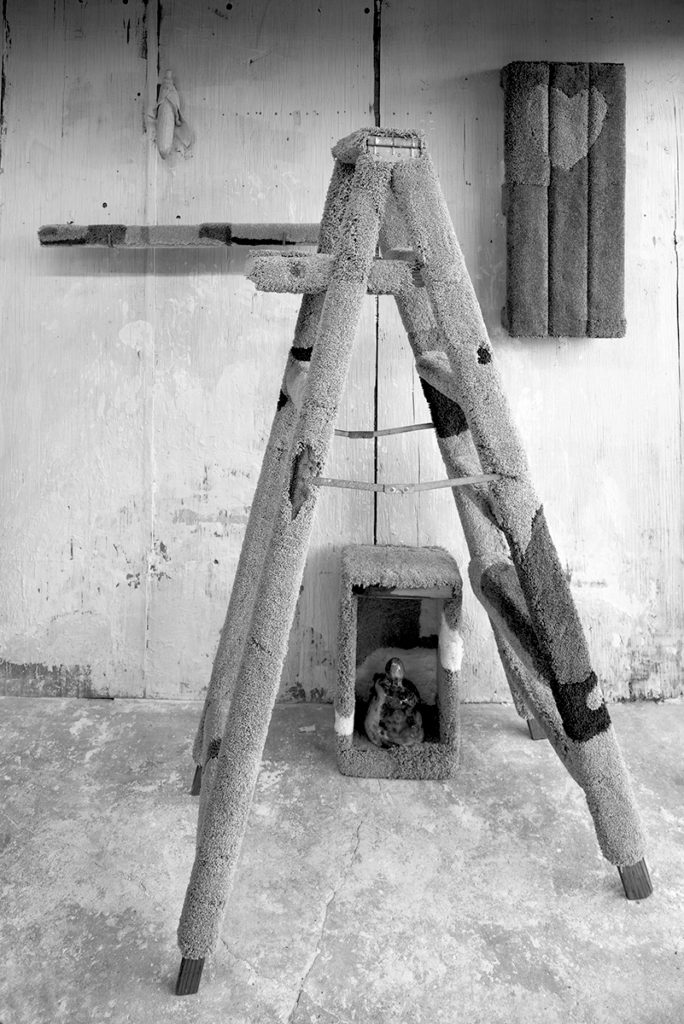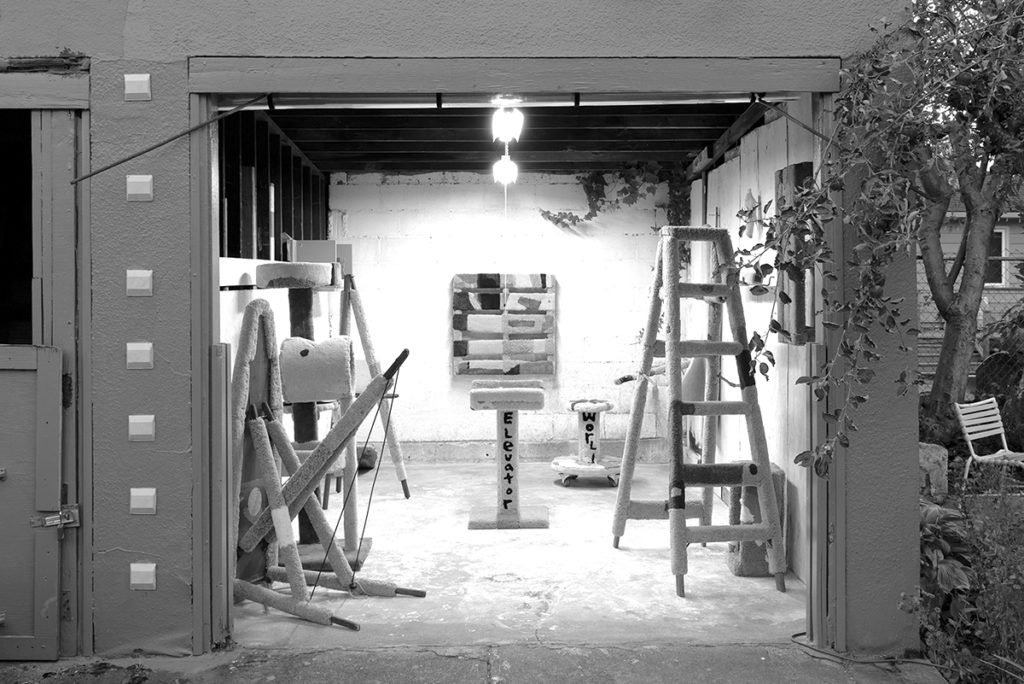The Cat Houses of Morgan Ritter
February 20, 2019
Text by Spencer Byrne-Seres
“Incidental” was one of the first words that leapt out at me in my conversations with Morgan Ritter about The Cat House Settlement. Incidental, a sort of by-product. An incident, a response, a result. Not necessarily an accident. Maybe an attitude, a mood, a situation. That the cat houses appear abstract, that they can be understood as art, is incidental. So clear are their primary function, that when Morgan was walking down the street carrying the ladder (see fig. 1), a couple ran out of their house to confirm and exclaim that it was, in fact, a cat house. These objects are everyday object, human structures, renovated for cats. Incidentally, they are covered in carpet.

I first came across The Cat House Settlement in a series of Instagram posts that Morgan made about their existence. The caption on one post read: “LOCAL OPPORTUNITY TO SQUEEZE MY CAT HOUSES: 3 of my “cat houses” (patchwork carpeted sculptures for cats aka human’s perception of cats via human language and material) are FOR SALE in PORTLAND…”
Human’s perception of cats via human language and material.
Morgan’s cat houses are questions, a material research project into perception by an artist who desires to move beyond simple human audiences. They began in response to the artist’s disappointment and trauma with human politics and the human art world. The cat houses offered a respite from a caustic environment though dissociation: a fantasy project, a post-human query into interspecies communication. It felt like the missing piece to SoFA Journal’s chosen theme, so I contacted Morgan immediately and we began talking about the work.
Morgan has been making these houses for years. All of the objects are found objects, as is most of the carpet. They are remnants that she finds on craigslist or in free piles to which she add innumerable hours of time and attention. There is a ladder, a pallet, an ironing board, a block of wood, a box, and a stick, all covered in carpet. Morgan states that “the scrapping is a technique of survival that I have cultivated in my creative practice. Working with what I have to achieve something paradoxical and almost unimaginable.” To this end she painstakingly collages together carpet, cut into shapes then assembled together in an instinctive way, through what is described as a snowballing process. Their composition starts with one shape or patch of carpet, then slowly envelopes the object. The colors are mostly muted tones of purple, blue, and beige; tones of carpet you would already find covering other cat houses. Interspersed in some are text: world, elevator. Poems for the humans, jokes for the cats, or vice versa.
When we talk about the cat houses, we always talk first in terms of cats. How do they climb them? Do they like them? What cat considerations are you making? Are they for particular cats, or a general cat audience? On a certain level the cat houses don’t need cats to function. Morgan is making assumptions about what cats might be interested in, but the process is dialogic, or even speculative. They are projections, imaginations by a human of what cats might need or want or be interested in. There does not need to be consensus among cats just as there does not need to be consensus among humans. And it is in the reception of this work where we learn about how others perceive the world. When I arrived at the studio, there was a cat, perched in the upper basket of the largest house, staring at me at eye level (fig 2). This almost came as a surprise. I wasn’t sure if the cats really engaged with the houses, but in that moment there was no doubt who the work was for.
Each of these objects points to an obvious fact of life: cats and humans cohabitate the world together. We share bathrooms and bedrooms and kitchens. And we fill these spaces with stuff. Stuff mostly designed for humans, save the dog bed in the corner or the kitty litter box in the garage. We expect cats to live in our houses, walk on our slippery floors, scramble over our appliances and underneath our beds. Morgan is pushing back, by wrapping our stuff in carpet. “No,” she is saying to the chair, “you are not just for humans.” The cat houses are puzzles, both for cats and for humans. For instance, there is a hunk of wood that is covered in carpet on one side, that rests on two sharpened pencils, titled “INTERSPECIES WORK TABLE” (fig. 3). The function of this object is no more apparent to the human than to the cat. But to both it poses a challenge, and perhaps an invitation to collaborate in what Morgan sees as a launchpad for post-human thinking.

The work has been presented in a number of ongoing formats: normally the cat houses live in Morgan’s garage studio, their natural environment. Cats and humans may come and go, seeking or discovering the cat houses as I did when I arrived for a studio visit. The work was also presented in a garage in Seattle. And online, the work is shown through Morgan’s website in a mock Craigslist page that lists all of the pieces and their prices. This last presentation is like insurance, lest the art world try to re-re-appropriate the work as sculpture. “This is not an exhibition,” she writes in reference to the works living in Seattle. The Craigslist page builds a certain logic of transaction into the work that is otherwise the product of “dissociation and fantasy.” The logic of transaction underlines the function of the work: she is creating supportive structures that are in turn able to support her.
As Morgan makes clear, the cat houses are not for the gallery; they have no function there. But where does art serve a function? Why does it have to live in ascetic white boxes and cold warehouses? We grapple with these questions much like a cat on a wooden floor, sliding around, trying to find our grip. Function is at the heart of Morgan’s inquiry, challenging the status quo, retreating from the standard functions and spaces in which art is produced and consumed. She has been making a list, attempting to catalogue the functions of art:
Art as a compromised result of accommodating an institution’s requirements
Art as no vacancy, or vacancy
Art as all you can eat
The list goes on and on, a detailed account of the artist’s perception and a reminder that through art we can actually learn about the world. The list reads not quite as a manifesto, but as a series of observations, or hypotheses. The cat houses are one of these hypotheses, erased from the list because they now exist in reality. Their existence proves their function, they are art as a cat house. As I sit here writing about them, I imagine a cat climbing on one in Morgan’s garage.
Morgan has started taking on commissions for new houses, for specific cats and specific people. Through the use of a questionnaire, she incorporates the cat’s preferences into the patterns and shapes of each unique cat house. Each will live out its life in a home, covered in fur or dust, slowly deteriorating through use and consideration. It is a never ending, ongoing project, and as the artist states, “Morgan will continue working on both projects for the remaining duration of her life.”



